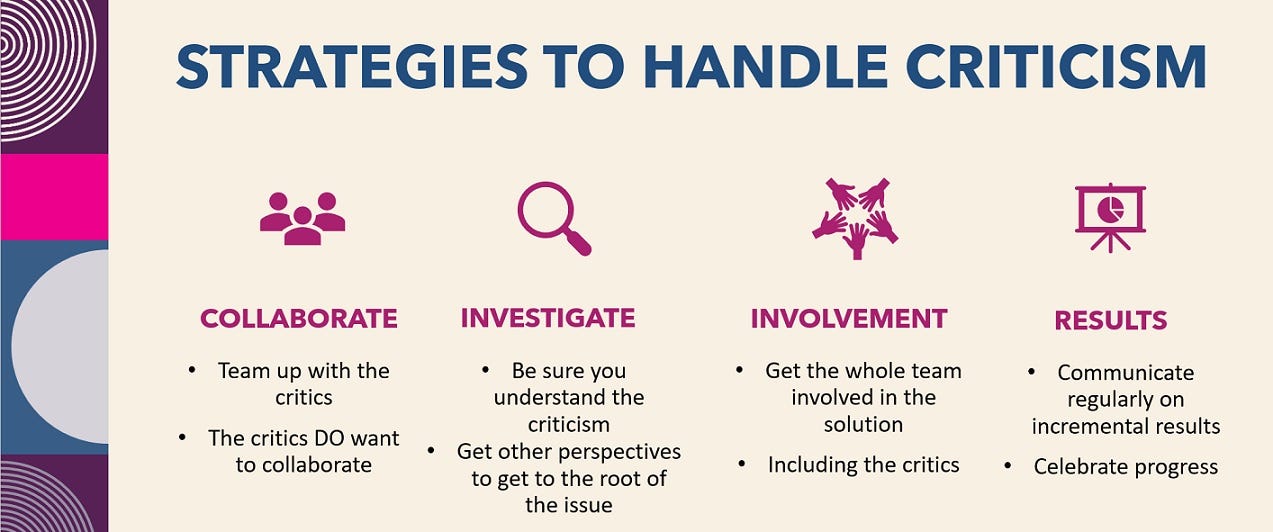Dealing with Internal Criticism
Turn Criticism into a Growth Opportunity
Dealing with internal criticism is part of the job for product leaders. You're comfortable handling constructive feedback on investment decisions and priorities you've set for the team. What do you do when internal criticism hurts the productivity of the team?
Some examples of unproductive criticism are:
It would be best if you lowered the forecast because there is nothing in the pipeline.
Your business case must stand on its own.
We have never done anything like this before.
How can you overcome this situation and get the team working together better? Let's discuss examples of winning over internal critics.
Example 1 New Product Introduction
You are responsible for getting your organization's first Software-as-a-Service (SaaS) product launched. Up to this point, your organization has never done any cloud-based products. Your competitors already offer cloud appliances. You defined requirements for the new SaaS products with phases to use the minimum resources possible in creating the new SaaS product.
Both engineering and finance are opposed to the new product and question if there is a business case for doing it. You acknowledge the feedback. You next review the customer perspective with engineering and finance together. Your customers want to move to Cloud and are held back since there is no SaaS product from your organization. You present the business case and ask for suggested solutions. After discussing alternatives, the team decides to get an early customer with help from tech marketing. Finance has some budget for a whitepaper on the early customer to build demand afterward. Getting the team together found a winning solution!
Example 2 New Product Launch and Sales Forecast Missed
Your new product launched several months ago and it isn't selling as forecasted in the business case. Due to budget constraints, there was no marketing and minimal sales training on the product. The few sales that closed were from existing customers with significant sales support from the product team. The early customer sales enabled sales of other products in the portfolio.
Since the sales are too low to cover the engineering costs, engineering and finance want to redirect the resources from your new product to an even newer product. Engineering and finance believe each product must show a good margin on a stand-alone basis.
You acknowledge the issue and bring in the perspective from marketing and sales before redirecting the resources. Marketing and sales explain that sales are lacking because customers don't know about the new product. You collaborate to properly launch the new product and plan for hitting the forecast. You provide ongoing updates on the marketing launch and new customer opportunities. This is enough to stop the reassignment of the people. Soon you celebrate the new sales with marketing, finance, and engineering!
Summary of Handling the Internal Critics
It is tricky to respond to internal criticism without becoming defensive. When you look past the criticism, you can find productive ways to respond. By reframing the criticism, you can build better relationships and get results:
Team up with the critics - they do want to collaborate
Be sure you understand the criticism - get other perspectives to get to the root of the issue
Get the whole team involved in the solution
Communicate regularly and celebrate progress
By embracing the internal critics you can turn issues into opportunities for growth.
Interesting Links
Preparing for Your Next Big Talk Product leaders often give presentations to stakeholders, customers, and colleagues. Jason Knight gives 6 steps to write, prepare and practice your next big speech.
Managing Your Backlog Thought-provoking way to escape being trapped by your backlog. You can feel free to close a backlog item by saying "not enough demand" after reading this article by David Pereira!



I love the point about teaming up with your internal critics, this works often for me. People want to be heard :D
My strategy is to take my time with feedback and criticism, which is where remote work has been an awesome avenue to advance as a PM.. Reactions are usually filled with emotion -- with some distance, I can find a way to take any criticism.
Thanks for the actionable tips and the whole strategy on how to handle criticism. Good post!